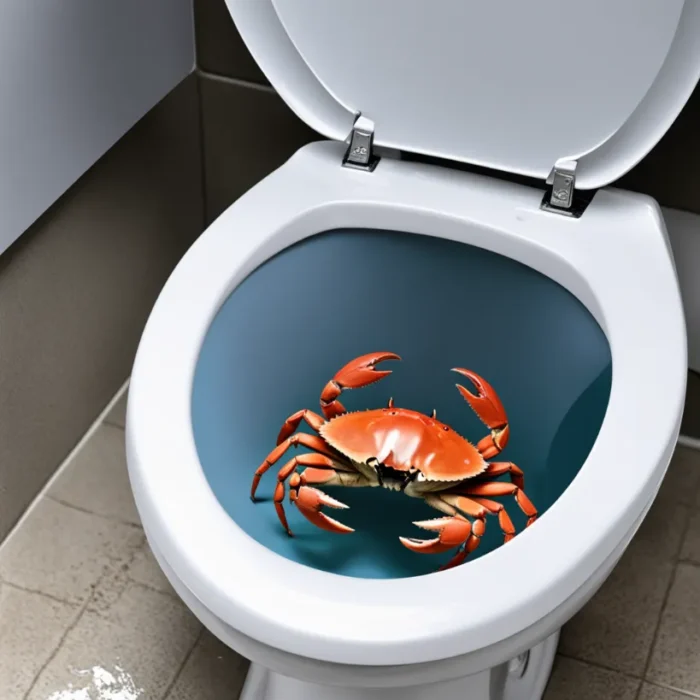When it comes to pubic lice, commonly referred to as crabs, there are a lot of myths and misunderstandings.
Many people are left wondering how these tiny, irritating parasites are transmitted and if catching them from a public toilet seat is a possibility.
Found mainly in the pubic area, these blood-sucking bugs can cause discomfort and distress.
However, before we jump to conclusions about their spread, it’s crucial to have a clear understanding of what crabs are, their life cycle, how they survive, and their common symptoms.
Furthermore, it’s vital to discern fact from fiction, one of the biggest being the infamous toilet seat myth.
| Aspect | Crabs from Toilet Seat |
|---|---|
| Transmission Risk | Low to Extremely Low |
| Method of Transmission | Highly Unlikely |
| Common Misconception | Often a Myth |
| Scientific Evidence | Lacks Substantial Proof |
| Hygiene Practices | Always Advisable |
| Prevention | Practicing Safe Hygiene |
| Actual Risk of Infection | Very Rare |
| Professional Opinion | Unlikely Scenario |
| Overall Concern | Minimal to Negligible |
Can You Really Catch Crabs from a Toilet Seat?
No, you cannot catch crabs from a toilet seat. Crabs, also known as pubic lice, require direct contact with human hair to infest. Toilet seats do not provide the necessary conditions for them to survive or transfer.
Understanding Pubic Lice (Crabs)
Pubic Lice: What are They?
Pubic lice, colloquially known as crabs, are small, parasitic insects that typically inhabit the pubic or genital area of humans.
They get their common name from their crab-like appearance under a microscope. While they are most commonly found in the pubic area, they can also live in other areas with coarse body hair, like the armpits or eyebrows.
These pests are not related to body lice or head lice.
How are Crabs Transmitted?
The primary mode of transmission for pubic lice is direct, skin-to-skin contact, especially during sexual activity.
It’s important to note that pubic lice can’t jump or fly. They crawl from hair to hair, making close contact necessary for transmission.
This also means that they aren’t typically spread through sharing clothing, bed linens, or towels, as they can’t survive long away from the warmth and humidity provided by the human body.
The idea that crabs can be caught from a toilet seat is largely debunked by healthcare professionals.
An infested person sitting on a toilet wouldn’t deposit any lice unless some fell off, an unlikely occurrence. Additionally, the lice can’t crawl from the toilet seat to your body because they need hair to move around.
Identifying a Pubic Lice Infestation
| Characteristic | Pubic Lice Infestation | Other Conditions (e.g., Dandruff, Folliculitis) |
|---|---|---|
| Location | Pubic region and hair | Scalp, eyebrows, eyelashes, or body hair |
| Visible Parasites | Tiny, crab-shaped bugs | None |
| Size | 1-2 mm in length | N/A |
| Color | Whitish-gray to brown | N/A |
| Movement | Slow crawling | N/A |
| Itching | Intense itching | Itching may be mild to severe |
| Rash or Bumps | Red or blue spots | Redness, pimples, or pustules |
| Eggs (Nits) | Oval, white or yellow | N/A |
| Attachment to Hair | Lice attach eggs firmly | N/A |
| Transmission | Through close contact | Varied (e.g., sharing personal items, bedding) |
| Treatment | Over-the-counter or prescription medications | Depends on the underlying condition |
| Hygiene Impact | No connection to hygiene | May improve with improved hygiene |
| Contagiousness | Easily spread through sexual contact or close contact | Typically not contagious between people except in certain cases |
| Duration of Infestation | Can persist if not treated | May resolve on its own or with treatment |
| Complications | Secondary bacterial infections, skin irritation | Secondary infections, scarring, or hair loss |
Pubic lice infestations, also known as crabs, are most commonly identified by a severe itch in the genital area, a symptom resulting from an allergic reaction to the lice’s saliva.
You may also notice small red bumps or tiny blue spots in the lower abdomen or on your thighs. If you look closely at the area that is itching, you may be able to spot the lice or their white oval eggs, referred to as nits, which are often stuck to the hairs.
If you suspect an infestation, it is vital to consult with a healthcare professional immediately.

Debunking the Toilet Seat Myth
Unraveling the Myth: Can You Catch Crabs from a Toilet Seat?
To put it briefly, the probability of catching crabs from a toilet seat is tremendously low. For a start, crabs are minuscule parasites that prefer to live in the warm and humid environment provided by pubic hair.
A female crab louse lays her eggs in this area, and the fledglings hatch roughly a week later reliant on this specific environment.
In contrast, a toilet seat tends to be cold and dry, which is not conducive to their survival. Even more, the lice can only live off the human body for 24 to 48 hours. Thus, the likelihood of the lice remaining alive long enough on a toilet seat and then managing to transmit to another person is nearly nil.
From Human to Human: The Common Mode of Transmission
In reality, crabs are typically transmitted through direct physical contact, and sexual intercourse is the most common mode of transmission.
They can also spread through shared clothes, bed linens, or towels with an infected person. The lice crawl from hair to hair, but they can’t jump or fly. As such, they have difficulties traversing gaps wider than a hair’s width.
This makes the prospect of them negotiating a relatively vast gap between a toilet seat and a person’s skin quite unlikely.
It’s crucial to understand that contracting pubic lice is not a result of poor personal hygiene, and it can happen to anyone who has close contact with the affected individual. Ensuring that people have the correct information helps in reducing unnecessary fear and stigma associated with this health issue.

From the knowledge we’ve gained, it’s clear to see that the toilet seat myth is busted. The survival rate of crabs outside of the human body is significantly low, especially on cold, hard surfaces such as a toilet seat.
They need the warmth and humidity found close to human skin for survival, making transmission from a toilet seat highly unlikely.
The most common mode of transmission is actually through close bodily contact, particularly sexual activity.
Therefore, our focus should be more on safe practices rather than unfounded fears. Remember, knowledge is power, and understanding the reality of pubic lice can go a long way in ensuring your own and others’ well-being.
Related Questions
What are the odds of getting crabs from a toilet seat?
The odds of getting crabs (pubic lice) from a toilet seat are extremely low to virtually nonexistent, as pubic lice require direct, prolonged contact with infested individuals or their belongings for transmission.
How long do crabs live on a toilet?
Crabs (pubic lice) do not typically survive for an extended period on a toilet seat or any other inanimate surface, as they rely on human blood for sustenance and cannot thrive outside the human body for long.
What are “crabs” in this context?
Crabs refer to pubic lice, which are parasitic insects that infest the pubic hair and genital area.
What is transmission in the context of disease?
In the context of disease, transmission refers to the process of transferring pathogens (such as bacteria, viruses, or parasites) from one person or surface to another.
What is a parasitic infection?
A parasitic infection occurs when a parasite, such as pubic lice, invades and lives within the body of its host, causing harm or discomfort.
What are toilet seat covers?
Toilet seat covers are disposable or reusable protective barriers placed on the toilet seat surface to prevent direct contact with the seat.
Is it true that you can catch crabs (pubic lice) from a toilet seat?
No, the notion of catching crabs from a toilet seat is often considered a myth. Pubic lice require close, prolonged contact with an infested person or their belongings to be transmitted.
They do not typically survive on toilet seats or other inanimate surfaces. Practicing good personal hygiene and using toilet seat covers can further reduce any minimal risk of transmission in public restrooms.




![How to Remove Crystallized Urine [Explained]](https://homepander.com/wp-content/uploads/2022/02/How-To-Remove-Crystallized-Urine.jpg)






![How To Clean Dark Grout That Has Turned White [5 Easy Ways]](https://homepander.com/wp-content/uploads/2021/12/How-To-Clean-Dark-Grout-That-Has-Turned-White.webp)